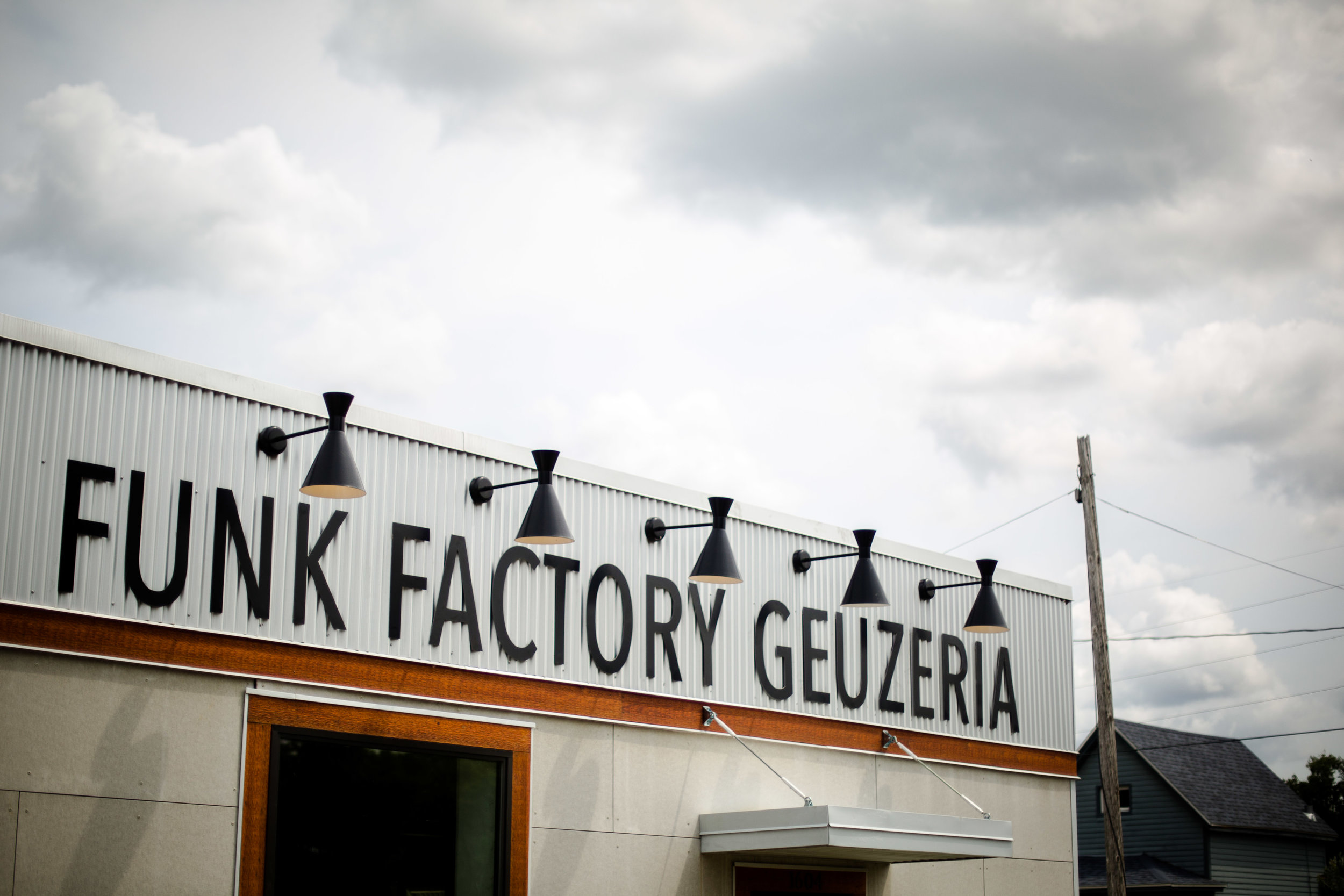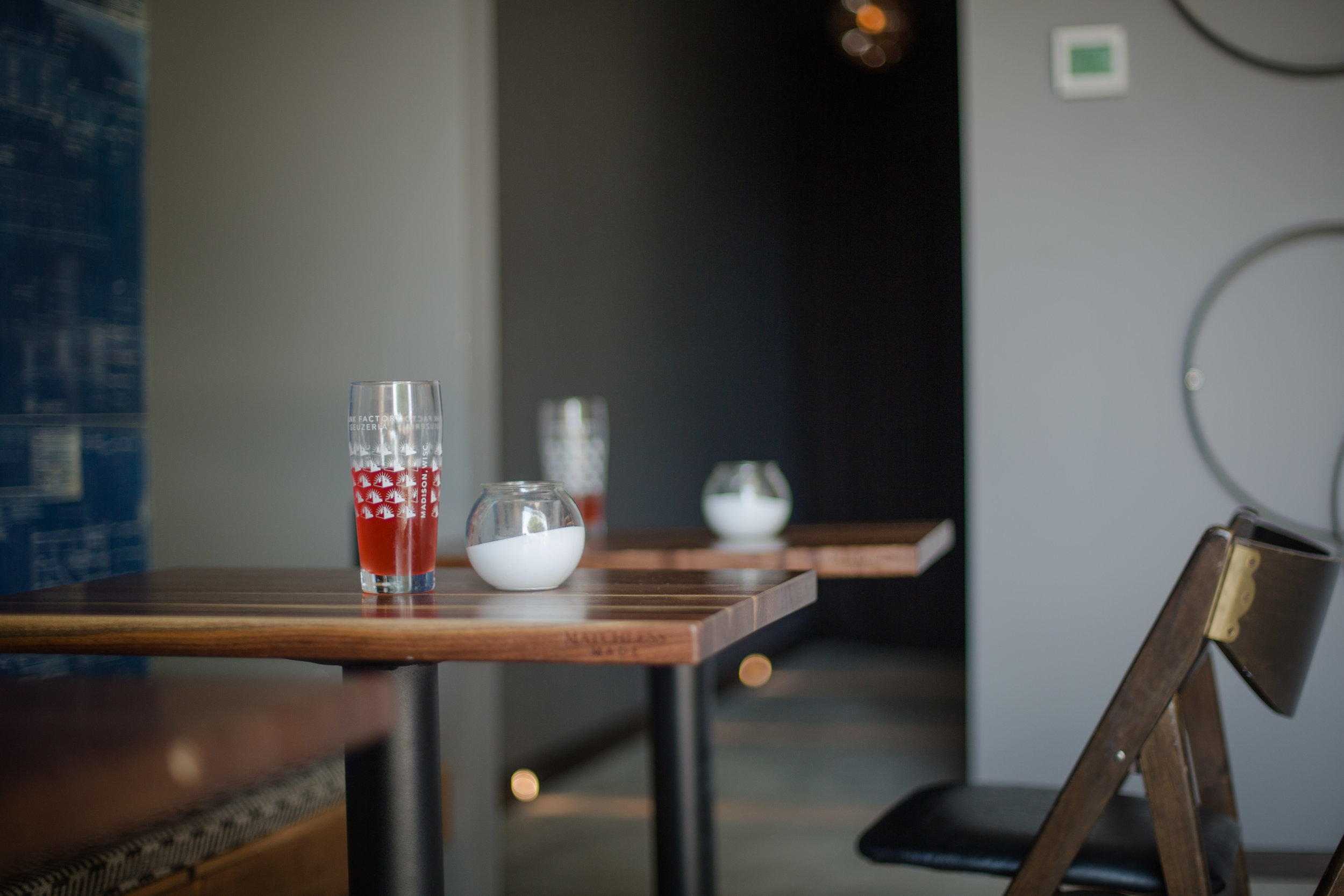Think back to the style that turned you into a beer person. For some, that obsession eventually becomes their calling. Levi Funk, founder and blender at Funk Factory Geuzeria, got into craft and was immediately enamored by Lambics. He bought and traded and acquired as many as possible while training his palate in the art of aging and blending.
“It all started in 2011," Funk says. "I filled a barrel in my basement. Now it just keeps expanding."
He'd go on to turn that single barrel into one of the most-watched breweries in the States.
Funk mentioned that aging basement barrel to O’So Brewing’s brewmaster Marc Buttera, who then sampled the blend. That impromptu tasting was the catalyst for the eventual barrel and taproom in Madison, Wisconsin.
The focus on Lambic came from that initial curiosity-turned-passion for the style. “There are a lot of interesting sours out there, but none share the complexity and discipline I find in Lambics,” Funk explains. “I could make other styles, but why?”
Complexities also exist in the relationship with Belgian producers who want to reserve the name Lambic for its country of origin. Determining the nomenclature of Lambic-style beers and blending in the U.S. has become an increasingly hot button issue on both sides of the Atlantic, but Funk has followed the traditional process so closely, he believes he’s created a legitimate case for the right to use the term Lambic, in one way or another, in the States.
Nevertheless, Texas farmhouse brewery Jester King recently negotiated a compromise with Belgium’s High Council for Artisanal Lambic Beers (HORAL) so that American producers can call their Lambic-style beer Mèthode Traditionnelle. Meanwhile, some of the country’s top sour and wild producers recently founded a guild “to push the education, quality, and nomenclature of sour beer in America.”
Funk says HORAL’s insistence on coming up with a new term for Lambic brewed in the U.S. seems to be strictly a pride issue. “Through this whole thing, they’ve never cared about how we make it, the process,” he says. “They don’t have a definition themselves. I call my beer an American Lambic because I don’t have a better term for it. It’s not right to call it an American sour or wild ale.”
“We’re following the traditional Belgian Lambic process to the letter,” Funk continues. “We wouldn’t take the extra steps and incur the extra expense if we weren’t trying to brew true to Lambic. To call it an American sour, which you could label an IPA with a little bacteria in it, doesn’t feel right.”
Funk Factory is licensed the same as any brewery with full production capabilities, but doesn’t actually house a brewing system. Instead, Funk sources his wort from a handful of different breweries in the surrounding area: Octopi Brewing in Waunakee, WI, Wisconsin Brewing in Verona, Penrose Brewing in Geneva, IL, and O’so Brewing. The latter was the brewery that acted as an incubator for Funk Factory during its initial stages.
“Building the barrel stock at O’so was extremely helpful. It takes three years to have a product to sell. Not having to pay rent or for equipment was about the only way I could start something like this,” Funk says. “There are others who are trying to start something similar and even with the best intentions, they’ll end up putting out an IPA just to stay afloat.”
He’s managed to keep Funk Factory afloat while maintaining his day job as an economist and has no plans to make the jump to blending full-time. “I like my job,” Funk says. “Being an economist is analytical. Funk Factory allows me to be creative and artistic.”
For day-to-day operations, Funk has opted to hire people who can fill the gaps in his knowledge and skillset. It’s been working well to this point as Funk Factory has since moved into their own home, a modest tap and barrel room on Gilson Street in Madison where all fermentation occurs once the wort has been produced.
The recipe for the base beer is the same for each brewery and uses a turbid mash that mirrors, as closely as possible, the method that Cantillon has used since 1900. Each brewery is left to their own devices in regards to where they source their ingredients.
“I want to use their local suppliers because I want there to be differences among the breweries making the wort,” Funk explains. “Creating variation from brewery to brewery makes sure I have something to blend across.”
“It’s kind of overwhelming at times. You just have to tell yourself to do your best and not fixate too much on any one thing. In the end, it’s spontaneous beer. You have to give up that idea of setting any type of schedule.”
Nuance is also seen in differences ranging from equipment such as heating sources and size of the system and water quality. Most importantly, it’s seen in how they manage the labor-intensive method of transferring wort through multiple temperature rests.
“Not every American brewery can do a turbid mash, because they’re not mechanically set up to do it,” Funk says. “It’s figuring out how you can mash in, hit temps, but also have a vessel that can hold and bring up to temp and being able to pump from that vessel back into your mash. Boil kettles don’t typically run back into a mash tun. It’s up to the brewery to figure out those transfers.”
Kirby Nelson of Wisconsin Brewing Company is one of the brewers who worked through a reconfiguration of his brew system to provide Funk with wort. The process was very much the first of its kind for Nelson, who called it a “guerrilla-style” brew day.
“First thing I had to do differently had nothing to do with the brewhouse,” Nelson says. “When Levi dropped the coolship off, I went outside to take a look and I had to shovel it. I never had to shovel snow out of a brewing vessel before.”
Kirby brews on an automated system that’s hard-piped and meant for traditional mashing. Brewing for a turbid mash presented a few challenges, including breaking apart the piping of his system to ensure the stability of the wort through the transfer back and forth between mash tun, lauter tun, and boil kettle while trying to get the right temperatures during each step.
“You’re also doing a very, very thick mash,” Nelson says. “I had to operate that by hand and go much slower than I normally would. We had to be patient. Normally a brew day will takes us five or seven hours, this was close to a 13-14 hour procedure, you’re just going back and forth and having to lauter so slow.”
“I’m wound up tight as can be, number one, because I like being that way. Number two, because it’s just a totally different process,” Nelson continues. “This is totally, ‘What the fuck are you doing?!’ you know what I mean? But it worked out incredibly well. It was a lot of fun and I couldn’t wait to do this for Levi.”
Once the wort is finished, Funk pumps it into his coolship that he then parks outside each of the breweries overnight to let the local yeast do their thing. While it’s long been a belief among wine-makers and blenders alike that different locations offer different microflora resulting in a different product based on geography, Funk believes that discussion is somewhat misguided.
“Some will say spontaneous fermentation will look different in Wisconsin as opposed to Chicago. I think that’s a romanticized notion,” Funk says. “The idea of local microflora is an argument for Lambic purists who don’t want the term ‘Lambic’ to be used in the U.S. It seems a bit preposterous to say a certain river valley has a unique microflora than the other side of the hill. But some people believe it.”
What does make a difference, Funk believes, is what happens once the wort is transferred to barrels. He prefers red wine barrels, primarily French oak, but has little interest in pulling any flavor from them. Each barrel is soaked, steamed, and bunged to help suck more of the wine out of the wood and then each gets a final rinse in an attempt to strip any remaining wine flavor before putting them to use. Once they’re filled, they’re stacked in rows inside Funk’s barrel room by season where they’ll sit for at least 30 months with intermittent tastings to test for quality.
Around nine months, phenols start to present themselves. Around 12 months, they begin to drop. By 18 months, they’re mostly cleared out. It doesn’t always happen this smoothly, which is part of the inherent risk of spontaneous fermentation.
“It’s a constant waiting game for phenol to drop off,” Funk says. “Sometimes you’ll have a batch where the phenols are super high. Then I’ll try it again a week later and suddenly it’s gotten better. I’m always tempted to dump them when this happens because I want to free up the space, but if you’re patient it could turn out to be amazing.”
The unpredictability of whether or not a given barrel (or barrels) will turn out to be a viable product for blending factors into decisions made across the entire operation, including any type of scheduling. With a lead time of at least 30 months, Funk is constantly thinking about the next three years, laying tracks for barrel aging based on when they’ll be ready while trying to continue to fill more barrels.
“It’s kind of overwhelming at times. You just have to tell yourself to do your best and not fixate too much on any one thing,” he adds. “In the end, it’s spontaneous beer. You have to give up that idea of setting any type of schedule.”
Beyond maneuvering time and limitations of physical space there exists the reality of certain batches never fully developing the way Funk would like. The amount that gets tossed in his limited time in dealing with mature product has proved to be a bit of a mystery. Up until this season, few barrels have been dumped, while this season seems to have provided more challenges in hitting the flavor profile he prefers. Funks fears about 20% of this year’s mature barrels may need to be dumped and he isn’t clear on what happened.
“I hop pretty aggressively,” he says. “There’s more hops in our wort than a lot of IPAs. I think the hops are having an interaction with the yeast that’s creating the phenols, even though the bitterness has aged out of them. It’s kind of a puzzle to figure out what works and what doesn’t from season to season. That’s the beauty of spontaneous fermentation. Or is it the ugly side? It could go either way.”
Whatever survives the long aging process is finally ready to be blended. Funk pores over the barrel stock to find the right flavor profiles that complement and build off of each other, and he then selects four barrels that are racked into a tote to create the final blend. Sometimes fruit is added, sometimes not. The beer sits in the totes for anywhere from four weeks to three months, when the Lambic is then racked off of the fruit and ready for bottling. It conditions for another three to six months in bottles before it’s sold.
For such a long lead time, the finished product doesn’t last very long. Funk sells tickets for bottle releases online to help contain the madness—it took all of 60 seconds for tickets on his latest four-barrel batch of his fruited Lambic Framrood to sell out.
Chris Hromada of Milwaukee has been participating in Funk Factory online bottle releases dating back to 2014 and has seen the demand for bottles increase as the beers gain popularity. “Back in the earlier releases, all you had to do was sign in to Brown Paper Tickets and be ready at the ‘go live’ time,” he explains. “As demand has increased, I’m refreshing the sale homepage precisely at the ‘go live’ time. Only until recently have I missed bottles during a public release. They were gone in less than a minute.”
Funk has put together a “Top 100” list that tracks customer loyalty by measuring the amount of money his super fans are spending on his bottle releases. As reward for that loyalty, he provides the Top 100 with early access to secure releases before the general public.
“It’s not something I signed up for, but it feels great that he recognizes the loyalty,” Hromada says. “I wish more breweries did this.”
That fast-moving product provides another problem to consider: how to keep up with demand? “Three years ago, I’m like, ‘Man, I filled 30 barrels. That’s twice what I was filling up at O’so.’ Now I’m like, ‘Oh shit, I only filled 30 barrels!’” Funk says, laughing. “My goal is to double what we filled every year. We filled about 80 Lambic barrels and three foeders, so double that for next year.”
“Some will say spontaneous fermentation will look different in Wisconsin as opposed to Chicago. I think that’s a romanticized notion. It seems a bit preposterous to say a certain river valley has a unique microflora than the other side of the hill. But some people believe it.”
The foeders Funk talks about are three 500-gallon vessels that were imported from Cognac, France. He’s using them to create Meerts, the product of a second-running on a Lambic brew day. After some trial and error using the actual second-running of a Lambic boil where the results came up watery, Funk decided to switch to a dedicated brew day this season. It’s the same Cantillon turbid mash, but scaled down to mimic second runnings with lower hop additions that are then transferred straight to the foeders for a quick three-month fermentation. Meerts has a mild flavor profile, low acidity, soft carbonation, and low ABV Fruit additions really shine in this style and make for some beautiful, sessionable beers.
Meerts is a fairly obscure thing, even in its native Belgium. “I’m in Belgium at the time, and I have Meerts sitting in vessels back home, and I ask a brewer there, ‘Tell me more about Meerts,’ because there’s so little information out there,” Funk remembers. “He says, ‘I don’t know, what’s that?’ A distributor seemed to translate and the brewer goes, ‘Oh, yeah. I don’t know. We’ve never done it. It is what it is.’”
Back in the Gilson Street taproom, Meerts has become a big part of Funk Factory’s model. Everything on draft in the taproom from the Geuzeria is a variation of Meerts, from peach, to cherry, to unfruited varieties. Meerts is still relatively unknown here in the States, which means Funk has found himself ahead of the curve in producing these beers.
“When we announced the first release of Meerts, I got two messages,” Funk says. “One from De Garde and one from Transient Ales saying, ‘You son of a bitch! You beat me to it!’”
The popularity of Lambic—and, potentially, Meerts—in the U.S. continues to rise, which means Funk has his work cut out for him. He’s already looking into more space nearby to help store barrels. And he's hoping to get more regular with online releases (he'd like to do one every month), all while finding rhythm and stability in a craft that's based in unpredictability.
Funk’s also started a second project, called Untitled Art, with Isaac Showaki of Octopi Brewing that focuses on making small-batch, highly creative beers that are sold in the taproom as well as a few outside accounts in the area.
“Untitled Art was born out of a desire to drink beer styles that aren’t found in Wisconsin and a frustration that other breweries here aren’t attempting them,” Funk explains. “I have yet to make any money on it at all. It’s just for fun.”
His efforts are gaining steam across the board, whether it’s in collaboration in naming the American Lambic, introducing the Meerts style to Stateside beer makers, or brewing his own line of beer to fill his fridge. Throughout all of it, the driving force is still in the blending, to which Funk has seen the most success thus far.
“That one-minute release sell-out felt really good,” Funk says. “Then I looked at how many barrels I filled that year and thought, ’Shit. I need to make more beer!’”







































